Temporal and Spatial Distributions of Ecological Vulnerability under the Influence of Natural and Anthropogenic Factors in an Eco-Province under Construction in China
Abstract
:1. Introduction
2. Materials and Methods
2.1. Study Area
2.2. Data Sources
2.3. Methodology
2.3.1. Ecological Vulnerability Evaluation Index System
2.3.2. The Calculation of the Second-Level Indicators
2.3.3. Index Standardization and the Determination of Weights
2.3.4. Ecological Vulnerability Grading Standard
2.3.5. Spatial Autocorrelation Analysis
2.3.6. Correlation Analysis
3. Results
3.1. Spatiotemporal Distribution of Ecological Vulnerability
3.1.1. Spatial Distribution of Ecological Vulnerability
3.1.2. Temporal Variations in Ecological Vulnerability
3.2. Autocorrelation Characteristics of Ecological Vulnerability
3.2.1. Global Spatial Autocorrelation
3.2.2. Local Spatial Autocorrelation
3.3. Effects of Natural and Anthropogenic Factors on Ecological Vulnerability
4. Discussion
- (1)
- The arable land area declined from 68,363.91 km2 in 2005 to 63,752.40 km2 in 2010 and 62,921.95 km2 in 2015, with a net decrease of 4611.51 km2 from 2005 to 2010 and 830.45 km2 from 2010 to 2015. In both phases, arable land was mainly converted to built-up land, accounting for 8.09% of arable land in 2005 and 7.05% in 2010. The reduction in arable land led to a more complex issue involving human activities and land use and management.
- (2)
- The woodland area decreased from 3352.49 km2 in 2005 to 3098.42 km2 in 2010 and 3049.91 km2 in 2015, with a net decrease of 254.07 km2 from 2005 to 2010 and 48.51 km2 from 2010 to 2015. From 2005 to 2015, the reclaimed area reached 195.57 km2 and accounted for 52.74% of the decreased area of woodlands. Reclamation and cultivation can cause extensive hydrological changes and soil erosion and deterioration of the eco-environment [9].
- (3)
- (4)
- Economic development activities are fundamental factors that influence ecological vulnerability [49]. The gross industrial production in Jiangsu Province increased from 9440.18 billion in 2005 to 19,277.65 billion in 2010 and 27,996.43 billion in 2015 [47]. Moreover, the industrial and mining land areas continued to increase from 1416.28 km2 in 2005 to 1421.05 km2 in 2010 and 1497.04 km2 in 2015, with a net increase of 4.77 km2 from 2005 to 2010 and 75.99 km2 from 2010 to 2015.
5. Conclusions
- (1)
- The effects of anthropogenic factors on ecological vulnerability were greater than those of natural factors, and the SHEI and LA were the main factors that influence ecological vulnerability.
- (2)
- Most parts of Jiangsu Province exhibited light and medium ecological vulnerability. The areal proportions of different vulnerability levels sorted in descending order are as follows: light ≈ medium > heavy > slight > extreme. Slight vulnerability mainly included the areas of lakes and canals. Light vulnerability areas were mainly distributed in paddy fields between the MICNJ and the Yangtze River. Medium, heavy and extreme vulnerability areas were mainly composed of arable and built-up land. Medium vulnerability was concentrated to the north of the MICNJ; heavy vulnerability was scattered to the south of the Yangtze River and in north-western hilly areas; and extreme vulnerability was concentrated in hilly areas.
- (3)
- Ecological vulnerability displayed a clustering characteristic. HH areas were mainly distributed in heavy and extreme vulnerability regions, and LL regions were associated with slight vulnerability areas.
- (4)
- Ecological vulnerability gradually deteriorated in the study area. From 2005 to 2010, the vulnerability in hilly areas obviously increased, and from 2010 to 2015, the vulnerability in urban and north-eastern coastal built-up land areas significantly increased.
Author Contributions
Funding
Conflicts of Interest
References
- Adger, W.N. Vulnerability. Glob. Environ. Chang. 2006, 16, 268–281. [Google Scholar] [CrossRef]
- Wang, X.D.; Zhong, X.H.; Gao, P. A GIS-based decision support system for regional eco-security assessment and its application on the Tibetan Plateau. J. Environ. Manag. 2010, 91, 1981–1990. [Google Scholar] [CrossRef]
- Zou, T.H.; Yoshino, K. Environmental vulnerability evaluation using a spatial principal components approach in the Daxing’anling region, China. Ecol. Indic. 2017, 78, 405–415. [Google Scholar] [CrossRef]
- Hou, K.; Li, X.X.; Zhang, J. GIS analysis of changes in ecological vulnerability using a SPCA model in the Loess Plateau of Northern Shaanxi, China. Int. J. Environ. Res. Public Health 2015, 12, 4292–4305. [Google Scholar] [CrossRef] [PubMed]
- Park, Y.S.; Chon, T.S.; Kwak, I.S.; Lek, S. Hierarchical community classification and assessment of aquatic ecosystems using artificial neural networks. Sci. Total Environ. 2004, 327, 105–122. [Google Scholar] [CrossRef] [PubMed]
- Liu, D.; Cao, C.X.; Dubovyk, O.; Tian, R.; Chen, W.; Zhuang, Q.F.; Zhao, Y.J.; Menz, G. Using fuzzy analytic hierarchy process for spatio-temporal analysis of eco-environmental vulnerability change during 1990–2010 in Sanjiangyuan region, China. Ecol. Indic. 2017, 73, 612–625. [Google Scholar] [CrossRef]
- Nguyen, A.K.; Liou, Y.A.; Li, M.H.; Tran, T.A. Zoning eco-environmental vulnerability for environmental management and protection. Ecol. Indic. 2016, 69, 100–117. [Google Scholar] [CrossRef]
- Wang, Y.; Ding, Q.; Zhuang, D.F. An eco-city evaluation method based on spatial analysis technology: A case study of Jiangsu Province, China. Ecol. Indic. 2015, 58, 37–46. [Google Scholar] [CrossRef] [Green Version]
- Shao, H.Y.; Liu, M.; Shao, Q.F.; Sun, X.F.; Wu, J.H.; Xiang, Z.Y.; Yang, W.N. Research on eco-environmental vulnerability evaluation of the Anning River Basin in the upper reaches of the Yangtze River. Environ. Earth Sci. 2014, 72, 1555–1568. [Google Scholar] [CrossRef]
- Bhuiyan, J.A.N.; Dutta, D. Analysis of flood vulnerability and assessment of the impacts in coastal zones of Bangladesh due to potential sea-level rise. Nat. Hazards 2012, 61, 729–743. [Google Scholar] [CrossRef]
- Cao, C.X.; Yang, B.; Xu, M.; Li, X.W.; Singh, R.P.; Zhao, X.J.; Chen, W. Evaluation and analysis of post-seismic restoration of ecological security in Wenchuan using remote sensing and GIS. Geomat. Nat. Hazards Risk 2016, 7, 1919–1936. [Google Scholar] [CrossRef]
- Martins, V.N.; Silva, D.S.; Cabral, P. Social vulnerability assessment to seismic risk using multicriteria analysis: The case study of Vila Franca do Campo (Sao Miguel Island, Azores, Portugal). Nat. Hazards 2012, 62, 385–404. [Google Scholar] [CrossRef]
- Eckert, S. Remote sensing-based assessment of tsunami vulnerability and risk in Alexandria, Egypt. Appl. Geogr. 2012, 32, 714–723. [Google Scholar] [CrossRef]
- Bosom, E.; Jimenez, J.A. Probabilistic coastal vulnerability assessment to storms at regional scale-application to Catalan beaches (NW Mediterranean). Nat. Hazards Earth Syst. Sci. 2011, 11, 475–484. [Google Scholar] [CrossRef] [Green Version]
- Buxton, M. Vulnerability to bushfire risk at Melbourne’s urban fringe: The failure of regulatory land use planning. Geogr. Res. 2011, 49, 1–12. [Google Scholar] [CrossRef]
- Pei, H.; Fang, S.F.; Lin, L.; Qin, Z.H.; Wang, X.Y. Methods and applications for ecological vulnerability evaluation in a hyper-arid oasis: A case study of the Turpan Oasis, China. Environ. Earth Sci. 2015, 74, 1449–1461. [Google Scholar] [CrossRef]
- Qiao, Z.; Yang, X.; Liu, J.; Xu, X.L. Ecological vulnerability assessment integrating the spatial analysis technology with algorithms: A case of the wood-grass ecotone of northeast China. Abstr. Appl. Anal. 2013, 2013, 1–8. [Google Scholar] [CrossRef]
- Song, G.B.; Chen, Y.; Tian, M.R.; Lv, S.H.; Zhang, S.S.; Liu, S.L. The Ecological Vulnerability Evaluation in Southwestern Mountain Region of China Based on GIS and AHP Method. Procedia Environ. Sci. 2010, 2, 465–475. [Google Scholar] [CrossRef] [Green Version]
- Ma, J.; Li, C.X.; Wei, H.; Ma, P.; Yang, Y.J.; Ren, Q.S.; Zhang, W. Assessment of ecological vulnerability in three Gorges area. Acta Ecol. Sin. 2015, 35, 1–13. [Google Scholar] [CrossRef]
- Aretano, R.; Semeraro, T.; Petrosillo, T.; Marco, A.D.; Pasimeni, M.R.; Zurlini, G. Mapping ecological vulnerability to fire for effective conservation management of natural protected areas. Ecol. Model. 2014, 295, 163–175. [Google Scholar] [CrossRef]
- Valois, C.H.; Martínez, R.C. Vulnerability of native forests in the Colombian Chocó: Mining and biodiversity conservation. Bosque 2016, 37, 295–305. [Google Scholar] [CrossRef]
- Yang, Y.J.; Ren, X.F.; Zhang, S.L.; Chen, F.; Hou, H.P. Incorporating ecological vulnerability assessment into rehabilitation planning for a post-mining area. Environ. Earth Sci. 2017, 76, 245. [Google Scholar] [CrossRef]
- Bárcena, J.F.; Gómez, A.G.; García, A.; Álvarez, C.; Juanes, J.A. Quantifying and mapping the vulnerability of estuaries to point-source pollution using a multi-metric assessment: The Estuarine Vulnerability Index (EVI). Ecol. Indic. 2017, 76, 159–169. [Google Scholar] [CrossRef]
- Malekmohammadi, B.; Jahanishaki, F. Vulnerability assessment of wetland landscape ecosystem services using driver-pressure-state-impact-response (DPSIR) model. Ecol. Indic. 2017, 82, 293–303. [Google Scholar] [CrossRef]
- Parthasarathy, A.; Natesan, U. Coastal vulnerability assessment: A case study on erosion and coastal change along Tuticorin, Gulf of Mannar. Nat. Hazards 2014, 75, 1713–1729. [Google Scholar] [CrossRef]
- Tapia, C.; Abajo, B.; Feliu, E.; Mendizabal, M.; Martinez, J.A.; Fernández, J.G.; Laburu, T.; Lejarazu, A. Profiling urban vulnerabilities to climate change: An indicator-based vulnerability assessment for European cities. Ecol. Indic. 2017, 78, 142–155. [Google Scholar] [CrossRef]
- Zhang, X.R.; Wang, Z.B.; Lin, J. GIS Based Measurement and Regulatory Zoning of Urban Ecological Vulnerability. Sustainability 2015, 7, 9924–9942. [Google Scholar] [CrossRef] [Green Version]
- Pearson, L.J.; Nelson, R.; Crimp, S.; Langridge, J. Interpretive review of conceptual frameworks and research models that inform Australia’s agricul-tural vulnerability to climate change. Environ. Model. Softw. 2011, 26, 113–123. [Google Scholar] [CrossRef]
- Li, Y.; Tang, G.A.; Yang, G.; Li, Y. Research progress of ecological vulnerability based on metrological analysis of literatures in China. J. Hunan Univ. Sci. Technol. 2012, 15, 91–94. [Google Scholar]
- Xu, C.G.; Feng, X.F.; Zheng, Z.W.; Shen, Z.T. Study on Characteristics for Spatial and Temporal Distribution in Jiangsu Province. Mod. Agric. Sci. Technol. 2014, 20, 236–239. [Google Scholar]
- Tan, J.H.; Tang, M.L. The theory of ecological footprint and the eco-province construction of Jiangsu. J. Nanjing Norm. Univ. 2006, 29, 121–126. [Google Scholar]
- Liu, J.Y.; Kuang, W.H.; Zhang, Z.X.; Xu, X.L.; Qin, Y.W.; Ning, J.; Zhou, W.S.; Zhang, S.W.; Li, R.D.; Yan, C.Z.; et al. Spatiaotemporal characteristics, patterns and causes of land-use changes in China since the late 1980s. J. Geogr. Sci. 2014, 24, 195–210. [Google Scholar] [CrossRef]
- Ding, Q.; Cheng, G.; Wang, Y.; Zhuang, D.F. Effects of natural factors on the spatial distribution of heavy metals in soils surrounding mining regions. Sci. Total Environ. 2017, 578, 577–585. [Google Scholar] [CrossRef] [PubMed]
- Ji, W.; Wang, Y.; Zhuang, D.F.; Song, D.P.; Shen, X.; Wang, W.; Li, G. Spatial and temporal distribution of expressway and its relationships to land cover and population: A case study of Beijing, China. Transp. Res. D 2014, 32, 86–96. [Google Scholar] [CrossRef] [Green Version]
- Zhou, F.J.; Chen, M.H.; Lin, F.X. R value of the indices of rainfall erosivity in Fujian province. J. Soil Water Conserv. 1995, 9, 13–18. [Google Scholar]
- Office of the Leading Group for the Development of the Western Region of the State Council, State Environmental Protection Administration of China. The Ecological Function Division Interim Regulations; Office of the Leading Group for the Development of the Western Region of the State Council, State Environmental Protection Administration of China: Beijing, China, 2002.
- Rouse, J.W.; Haas, R.W.; Schell, J.A.; Deering, D.W.; Harlan, J.C. Monitoring the Vernal Advancement and Retrogradation (Green Wave Effect) of Natural Vegetation; NASA: Washington, DC, USA, 1974.
- Meng, M.; Ni, J.; Zhang, Z.G. Geographical ecology of aridity index and its application. J. Plant Ecol. 2004, 28, 853–861. [Google Scholar]
- Zhang, G.P.; Zhang, Z.X.; Liu, J.Y. Analysis of spatial patterns and driving factors of soil wind erosion in China. Acta Geogr. Sin. 2001, 56, 146–158. [Google Scholar]
- Zhuang, D.F.; Liu, J.Y. Study on the model of regional differentiation of land use degree in China. J. Nat. Resour. 1997, 12, 105–111. [Google Scholar]
- Zhang, Z.Q.; Zhang, J.; Huang, G.B. Ecological sensitivity and managemental countermeasures of envrionments in Qingyang city, Gansu province. J. Desert Res. 2010, 30, 614–619. [Google Scholar]
- Brejda, J.J.; Moorman, T.B.; Karlen, D.L.; Dao, T.H. Identification of regional soil quality factors and indicators: I. Central and southern high plain. Soil Sci. Soc. Am. 2000, 64, 2115–2124. [Google Scholar] [CrossRef]
- Shi, H.; Yang, Z.P.; Han, F.; Shi, T.G.; Luan, F.M. Characteristics of temporal-spatial differences in landscape ecological security and the driving mechanism in Tianchi scenic zone of Xinjiang. Prog. Geogr. 2013, 32, 475–485. [Google Scholar] [CrossRef]
- Zhao, Y.X.; Liu, X.; Qin, Y.J.; Xu, Q.H. LUCC and its impact on vulnerability of agro-pastoral areas in Hebei province. Res. Soil Water Conserv. 2011, 18, 205–211. [Google Scholar]
- Qiao, Z. The Impact Assessment of Ecological Vulnerability Based on the Land-Use in the Transitional Area between Forest and Grass Regions in Northeast China. Master’s Thesis, Shandong Normal University, Jinan, China, 2011. [Google Scholar]
- Fan, S.L.; Guo, Y.S.; Qiu, L.J.; Jiang, C.; Huang, Y.H. Analyzing the effects of land cover change on urban ecological vulnerability in the central districts of Fuzhou city. J. Fujian Norm. Univ. 2018, 34, 92–98. [Google Scholar] [CrossRef]
- Jiangsu Statistical Yearbook. Available online: http://www.jssb.gov.cn/2016nj/indexc.htm (accessed on 29 August 2018).
- Hong, W.; Jiang, R.R.; Yang, C.Y.; Zhang, F.F.; Su, M.; Liao, Q. Establishing an ecological vulnerability assessment indicator system for spatial recognition and management of ecologically vulnerable areas in highly urbanized regions: A case study of Shenzhen, China. Ecol. Indic. 2016, 69, 540–547. [Google Scholar] [CrossRef]
- Lee, Y. Social vulnerability indicators as a sustainable planning tool. Environ. Impact Assess. 2014, 44, 31–42. [Google Scholar] [CrossRef]
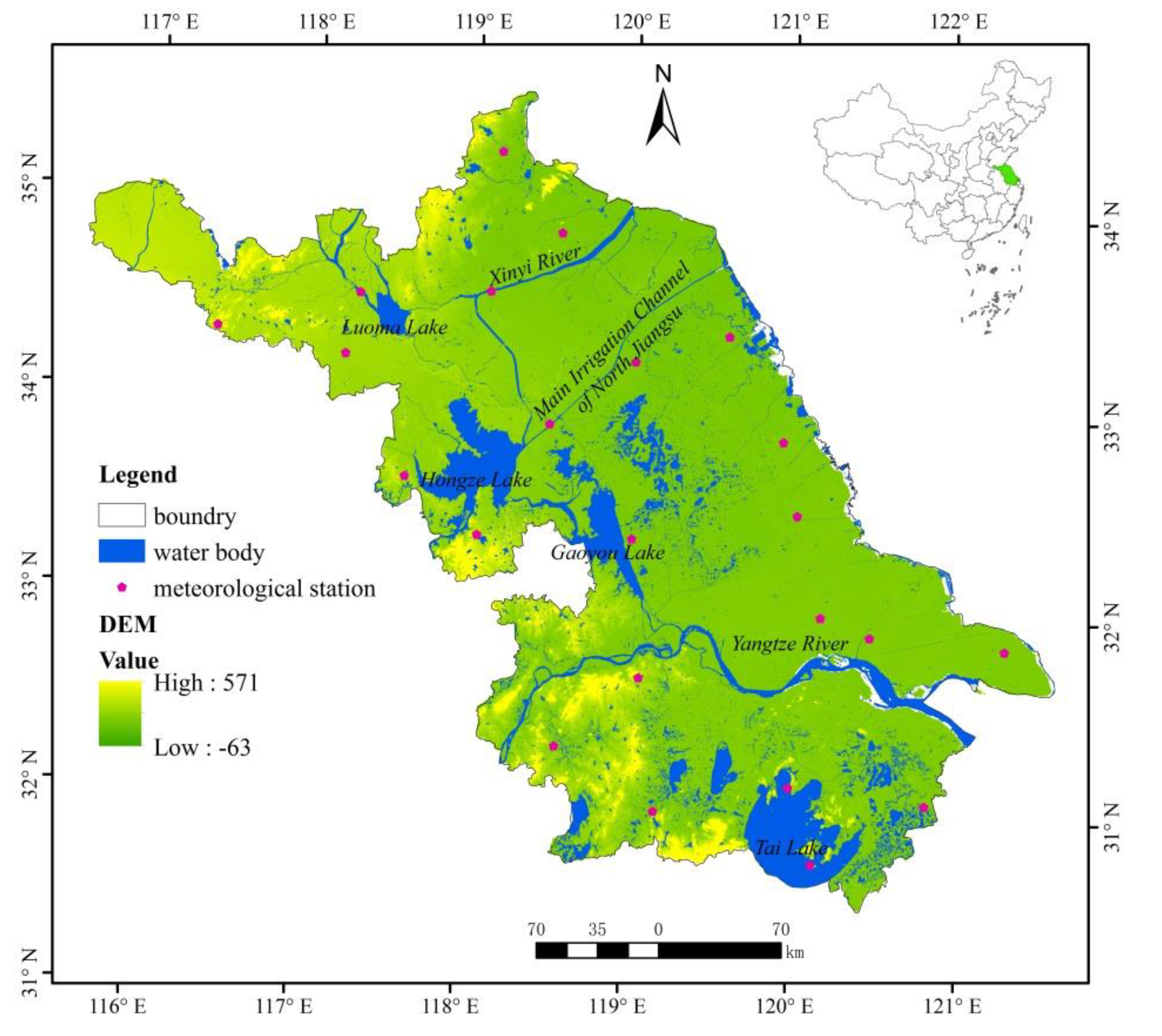
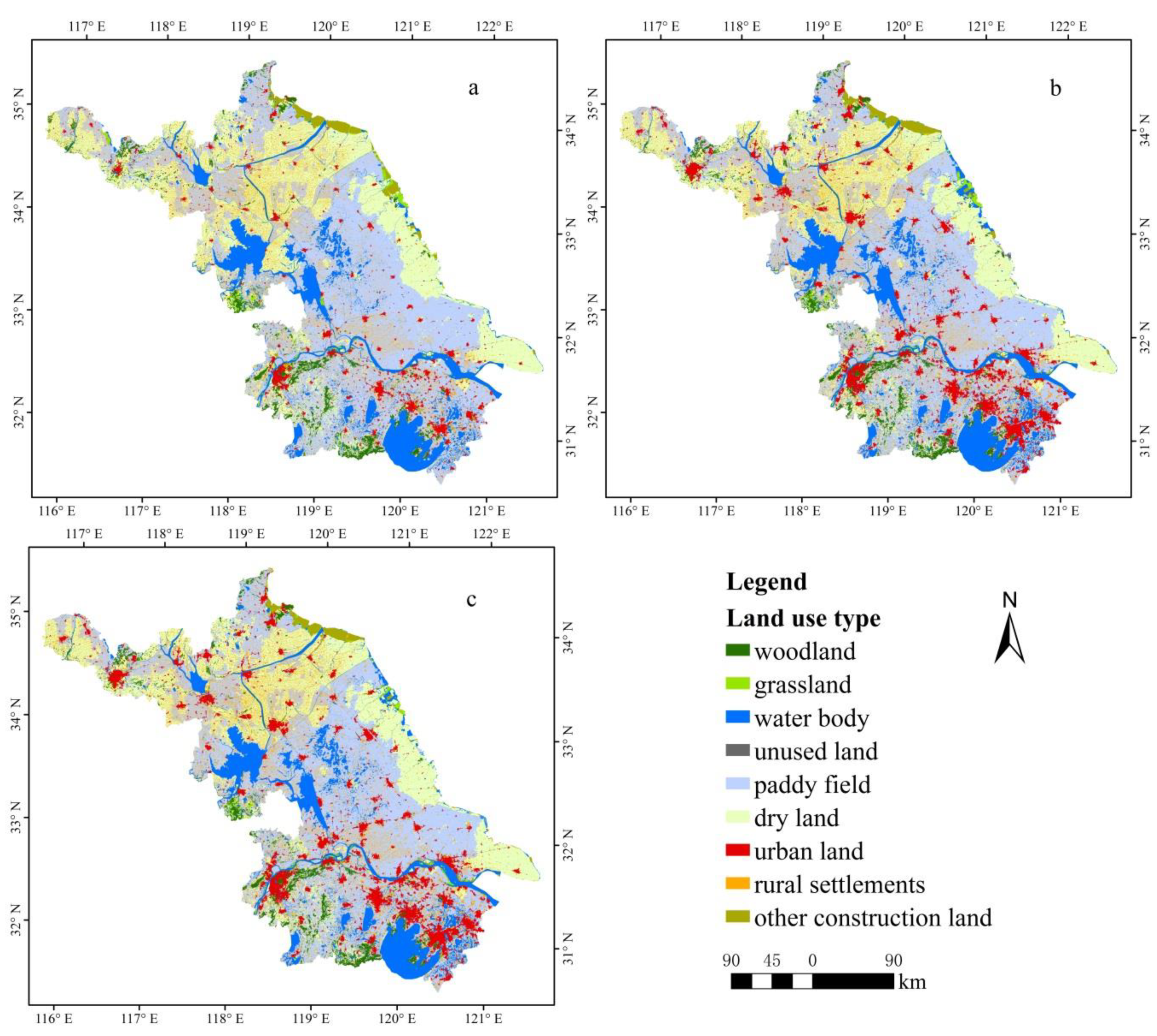
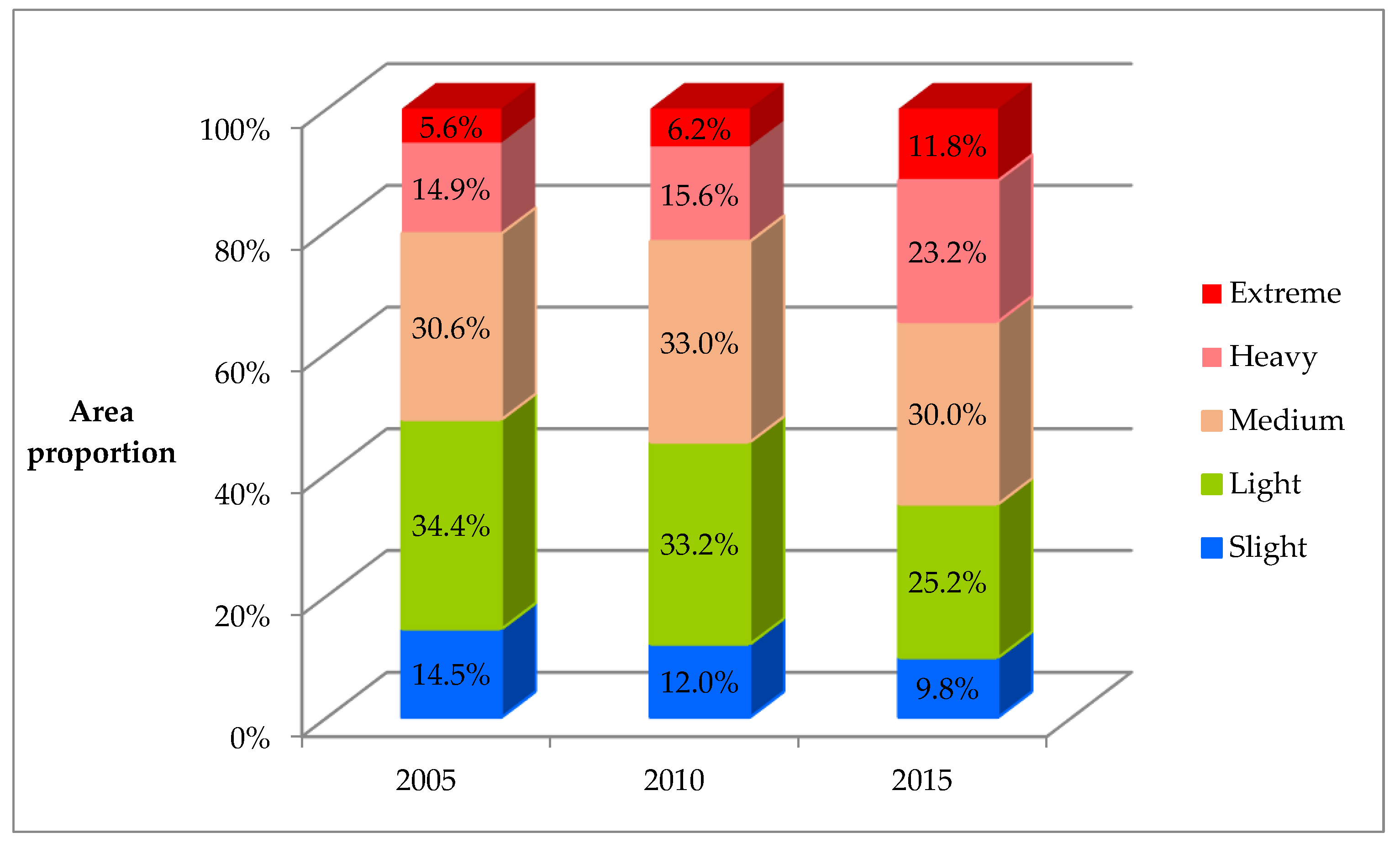
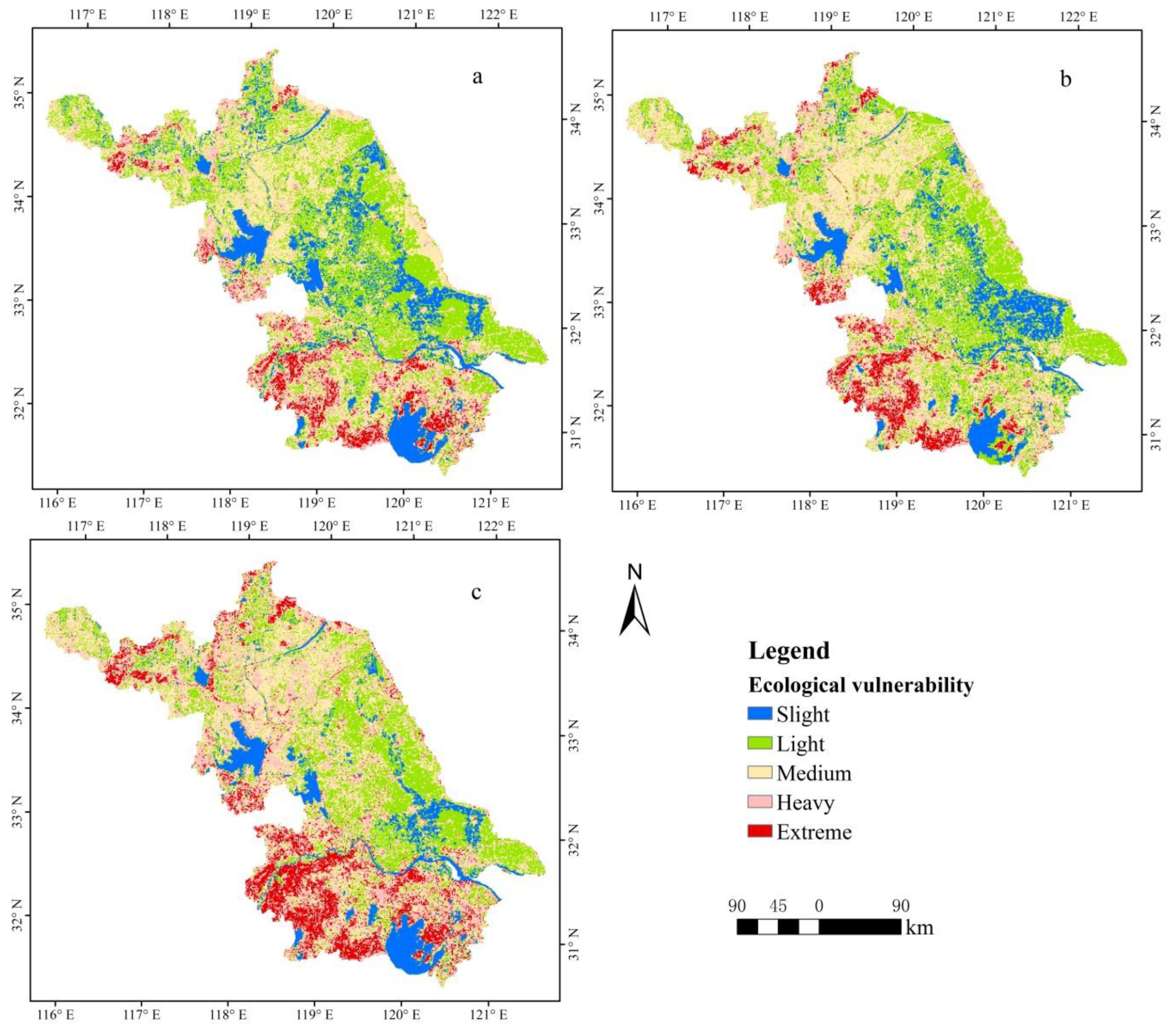


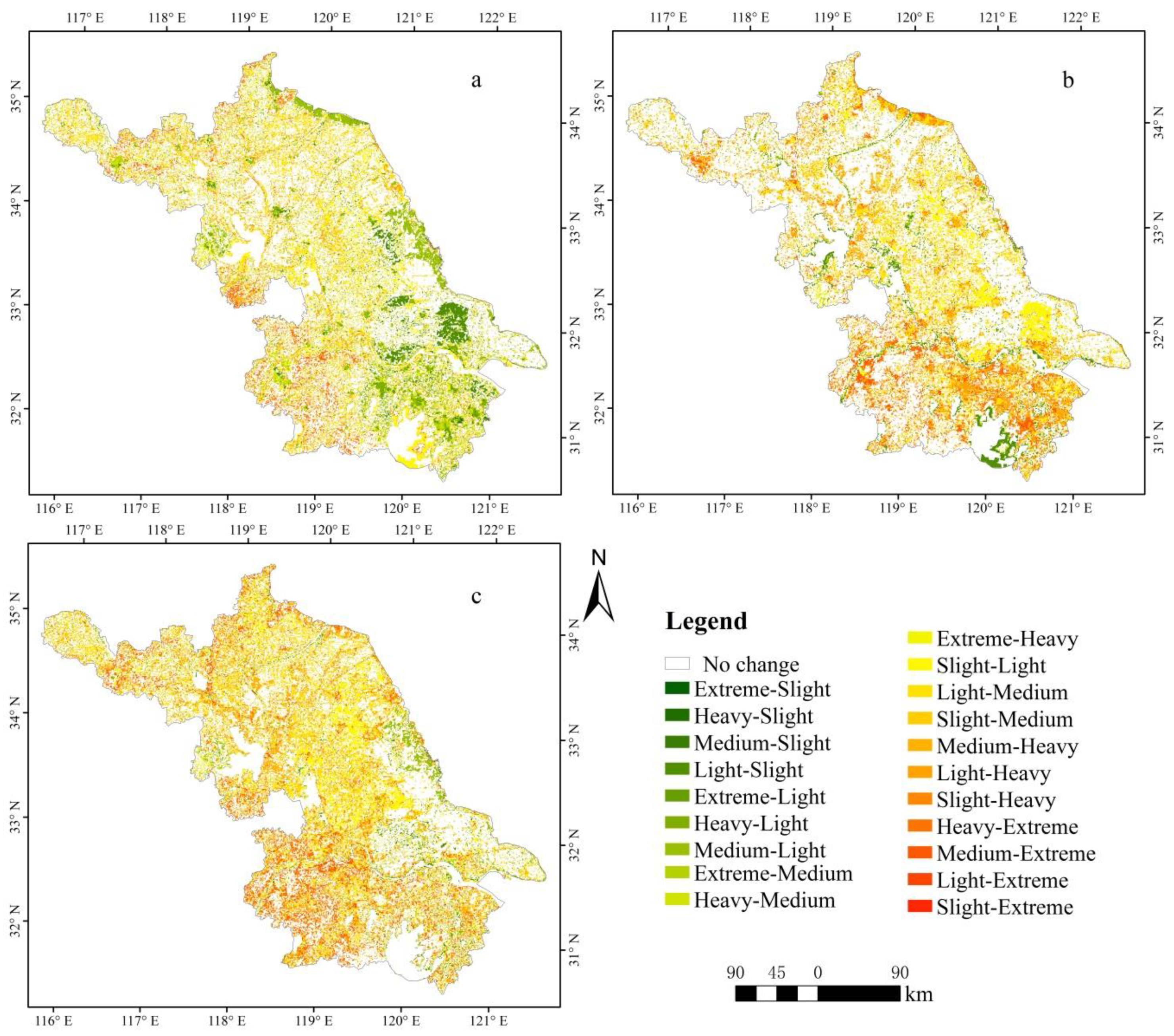

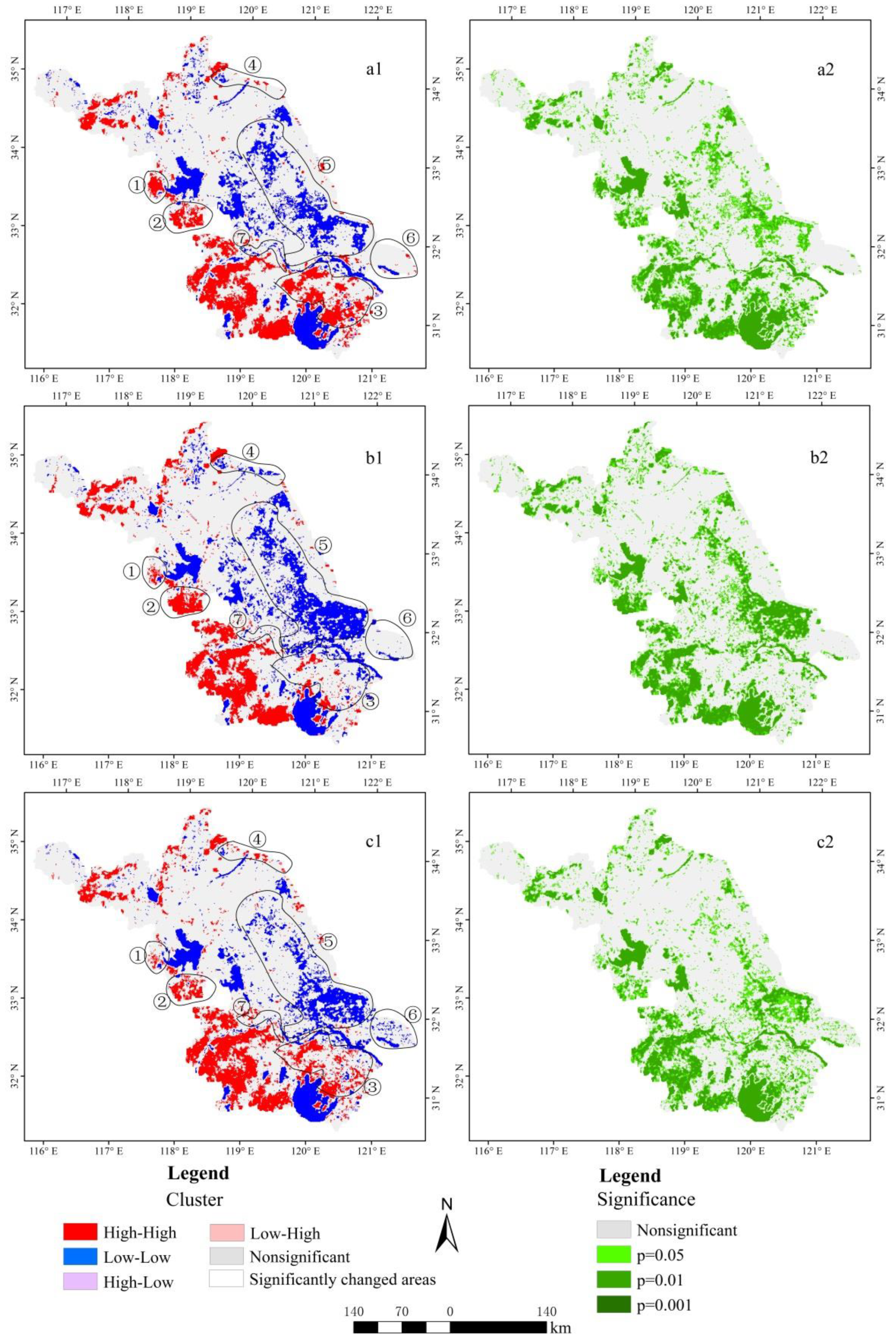
| Upper-Level Classification | Second-Tier Classification | ||
|---|---|---|---|
| Code | Type | Code | Type |
| 1 | arable land | 11 | paddy field |
| 12 | dry land | ||
| 2 | woodland | 21 | forest land |
| 22 | shrubwood | ||
| 23 | sparse woodland | ||
| 24 | other woodland | ||
| 3 | grassland | 31 | high coverage grassland |
| 32 | medium coverage grassland | ||
| 33 | low coverage grassland | ||
| 4 | water body | 41 | canal |
| 42 | lake | ||
| 43 | reservoir pond | ||
| 44 | permanent glacier snow | ||
| 45 | coastal beach | ||
| 46 | overflow land | ||
| 5 | built-up land | 51 | urban land |
| 52 | rural settlements | ||
| 53 | other construction land | ||
| 6 | unused land | 61 | sand |
| 62 | gobi | ||
| 63 | saline alkali land | ||
| 64 | marsh land | ||
| 65 | bare land | ||
| 66 | bare rock and gravel land | ||
| 67 | other unused land | ||
| Target Layer | Criterion Layer | First-Level Indicator | Second-Level Indicator |
|---|---|---|---|
| Pressure | Ecological sensitivity | Soil erosion sensitivity (ES) | |
| Soil desertification sensitivity (DS) | |||
| Ecological | State | Landscape pattern | Landscape patch density (PD) |
| vulnerability | Landscape evenness (SHEI) | ||
| Response | Land resource utilization degree | Land resource utilization degree (LA) |
| Second-Level Index | Description | Single Factor | ||
|---|---|---|---|---|
| Factor | Formula | Operation | ||
| ES | Precipitation, topography, vegetation and soil factors, including rainfall erosivity (R), relief (LS), land use types (CM) and soil texture (ST), are used to evaluate ES using GIS technology. , where is the sensitivity level of i. | R | . R is the annual rainfall erosivity (J·cm/m2·h); Pi is the monthly mean rainfall (mm) [35]. | The monthly mean rainfall totals at 23 stations were calculated based on the daily mean rainfall. The R value at any station was then calculated, and the spatial distribution of R at a 1000-m resolution was obtained by the inverse distance weighted (IDW) interpolation method. Reclassification was performed according to Table 4 to obtain an R grade distribution map. |
| LS | - | A 5 km × 5 km window analysis was conducted using the digital elevation model (DEM) to generate a LS spatial distribution map at a 500-m resolution. The map was then resampled to 1000 m using the nearest neighbor method. The reclassification to the LS grade distribution map was based on Table 4. | ||
| CM | - | According to Table 4, the land use raster data were reclassified into a CM grade distribution map. | ||
| ST | - | The ST spatial distribution was obtained from the integration of the raster data of the sand, silt and clay percentages with the con() function embedded in the raster calculator model of ArcGIS. This process was implemented according to the international grading standards for soil texture. The data were then reclassified to obtain an ST grade distribution map according to Table 4. | ||
| DS | DS was evaluated based on the vegetation coverage (C), moisture index (I), soil matrix (SM) and number of gale days (G) [36]. , where is the sensitivity level of i. | C | . NDVImin, NDVImax are the minimum and maximum of NDVI [37]. | The C spatial distribution was calculated from the normalized difference vegetation index (NDVI) using the raster calculator in ArcGIS 10.2. The data were then reclassified to a C grade distribution map according to Table 4. |
| I | . is the annual cumulative temperature not less than ; r is the annual rainfall during [38]. | The annual accumulated temperature was calculated based on the daily mean temperature at each station. The annual rainfall during the period of daily mean temperature was computed based on the daily mean rainfall. Then, the I value at any station was calculated and interpolated to obtain an I spatial distribution map at a 1000-m resolution. The reclassification to the I grade distribution map was performed according to Table 4. | ||
| G | - | The number of days when the daily wind speed was greater than 6 m/s from December to May was determined for each meteorological station [39]. A G spatial distribution map at a 1000-m resolution was then obtained through IDW interpolation of the day numbers. Reclassification was performed to obtain a G grade distribution map according to Table 4. | ||
| SM | - | According to Table 4, the ST spatial distribution was reclassified to an SM grade distribution map. | ||
| PD | - | PD | . N is the number of patches in the landscape unit; A is the area of landscape unit. | Grid method. A 1 km × 1 km fishnet was created and intersected with the land use vector data. Attribute statistics were obtained for the intersected data to determine N and A, and PD for each grid. The data table was joined to the fishnet, and the fishnet was rasterized with PD as the attribute value. |
| SHEI | SHEI equals the Shannon diversity index divided by the maximum possible diversity for a given landscape abundance. It can directly reflect the uneven distribution of patches, that is, landscape heterogeneity in a landscape system. | SHEI | . p(i) is the area proportion of land use type i in a grid; T is the total number of land use types. | Grid method. The specific steps refer to the calculation of PD. |
| LA | - | LA | . Ai is the land use degree grading index; Ci is the area proportion of level i in a grid. Land use degree grading standard is shown in Table 5. | Grid method. The specific steps refer to the calculation of PD. The land use degree grading standards refer to Zhuang and Liu [40]. |
| Factor | Slight Sensitivity | Light Sensitivity | Medium Sensitivity | Heavy Sensitivity | Extreme Sensitivity |
|---|---|---|---|---|---|
| R | <25 | 25–100 | 100–400 | 400–600 | >600 |
| LS | <20 | 20–50 | 50–100 | 100–300 | >300 |
| CM | Water, swamp, paddy field | Broadleaf forest, coniferous forest, meadow, shrub and coppice forests | Sparse woods grassland, garden, dry land | Desert, settlements, sparse grassland | No vegetation area, bare land |
| ST | Gravel | Loamy sand | Sandy loam, sandy clay, sandy clay loam | Loam, clay loam, loam clay | Silty loam, silty clay loam, clay, silty clay |
| C | >0.7 | 0.5–0.7 | 0.3–0.5 | 0.1–0.3 | <0.1 |
| I | >0.65 | 0.5–0.65 | 0.2–0.5 | 0.05–0.2 | <0.05 |
| G | <15 | 15–30 | 30–45 | 45–60 | >60 |
| SM | Pedestal rock | Viscidity | Gravel | Loamy texture | Sandiness |
| Value | 1 | 3 | 5 | 7 | 9 |
| Type | Unused Land Level | Forest, Grass, Water Level | Agricultural Land Level | Urban Settlements Land Level |
|---|---|---|---|---|
| Land use type | The land unused and difficult to use | Forest, grass, water | Farmland, garden, artificial turf | Urban, settlement, industrial land, transportation land |
| Grading index | 1 | 2 | 3 | 4 |
| Index | Weight | ||
|---|---|---|---|
| 2005 | 2010 | 2015 | |
| ES | 0.325 | 0.333 | 0.328 |
| DS | 0.286 | 0.107 | 0.289 |
| PD | 0.075 | 0.058 | 0.053 |
| SHEI | 0.258 | 0.277 | 0.281 |
| LA | 0.056 | 0.225 | 0.049 |
| 2005 | ||||||
| Indicator | Vulnerability | ES | DS | PD | SHEI | LA |
| vulnerability | 1 | 0.523 ** | 0.047 ** | 0.791 ** | 0.797 ** | 0.754 ** |
| ES | 1 | −0.001 | 0.456 ** | 0.396 ** | 0.568 ** | |
| DS | 1 | −0.040 * | −0.035 | −0.014 | ||
| PD | 1 | 0.838 ** | 0.643 ** | |||
| SHEI | 1 | 0.525 ** | ||||
| LA | 1 | |||||
| 2010 | ||||||
| Indicator | Vulnerability | ES | DS | PD | SHEI | LA |
| Vulnerability | 1 | 0.534 ** | 0.074 ** | 0.813 ** | 0.828 ** | 0.741 ** |
| ES | 1 | 0.079 ** | 0.420 ** | 0.376 ** | 0.542 ** | |
| DS | 1 | 0.074 ** | 0.051 ** | 0.051 ** | ||
| PD | 1 | 0.847 ** | 0.632 ** | |||
| SHEI | 1 | 0.518 ** | ||||
| LA | 1 | |||||
| 2015 | ||||||
| Indicator | Vulnerability | ES | DS | PD | SHEI | LA |
| Vulnerability | 1 | 0.505 ** | 0.088 ** | 0.789 ** | 0.783 ** | 0.776 ** |
| ES | 1 | 0.091 ** | 0.421 ** | 0.370 ** | 0.538 ** | |
| DS | 1 | 0.079 ** | 0.048 ** | 0.060 ** | ||
| PD | 1 | 0.846 ** | 0.635 ** | |||
| SHEI | 1 | 0.515 ** | ||||
| LA | 1 | |||||
| Ecological Vulnerability (year) | ES | DS | PD | SHEI | LA |
|---|---|---|---|---|---|
| Vulnerability (2005) | 0.102 ** | 0.164 ** | 0.129 ** | 0.497 ** | 0.535 ** |
| Vulnerability (2010) | 0.207 ** | 0.031 | 0.137 ** | 0.548 ** | 0.512 ** |
| Vulnerability (2015) | 0.097 * | 0.06 ** | 0.112 ** | 0.472 ** | 0.593 ** |
© 2018 by the authors. Licensee MDPI, Basel, Switzerland. This article is an open access article distributed under the terms and conditions of the Creative Commons Attribution (CC BY) license (http://creativecommons.org/licenses/by/4.0/).
Share and Cite
Ding, Q.; Shi, X.; Zhuang, D.; Wang, Y. Temporal and Spatial Distributions of Ecological Vulnerability under the Influence of Natural and Anthropogenic Factors in an Eco-Province under Construction in China. Sustainability 2018, 10, 3087. https://doi.org/10.3390/su10093087
Ding Q, Shi X, Zhuang D, Wang Y. Temporal and Spatial Distributions of Ecological Vulnerability under the Influence of Natural and Anthropogenic Factors in an Eco-Province under Construction in China. Sustainability. 2018; 10(9):3087. https://doi.org/10.3390/su10093087
Chicago/Turabian StyleDing, Qian, Xun Shi, Dafang Zhuang, and Yong Wang. 2018. "Temporal and Spatial Distributions of Ecological Vulnerability under the Influence of Natural and Anthropogenic Factors in an Eco-Province under Construction in China" Sustainability 10, no. 9: 3087. https://doi.org/10.3390/su10093087





